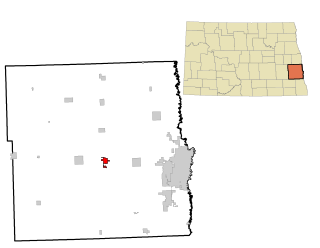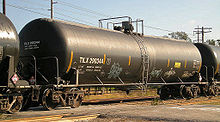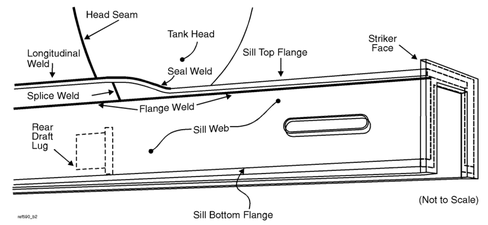
Casselton is a city in Cass County, North Dakota, United States. The population was 2,479 at the 2020 census. making it the 20th largest city in North Dakota. Casselton was founded in 1876. The city is named in honor of George Washington Cass, a president of the Northern Pacific Railway, which established a station there in 1876 to develop a town for homesteaders. Casselton is the hometown of five North Dakota governors.

A tank car or tanker is a type of railroad car or rolling stock designed to transport liquid and gaseous commodities.

The Weyauwega derailment was a railroad accident that occurred in Weyauwega, Wisconsin, United States, in the early morning hours of March 4, 1996. The derailed train was carrying a large quantity of hazardous material, which immediately caught fire. The fire, which involved the train cars and an adjacent feed mill, burned for more than two weeks after the actual derailment, resulting in the emergency evacuation of 2,300 people for 18 days, including the entire city of Weyauwega, with about 1,700 evacuees.

The Transportation Safety Board of Canada, officially the Canadian Transportation Accident Investigation and Safety Board is the agency of the Government of Canada responsible for advancing transportation safety in Canada. It is accountable to Parliament directly through the President of the King’s Privy Council and the Minister of Intergovernmental and Northern Affairs and Internal Trade. The independent agency investigates accidents and makes safety recommendations in four modes of transportation: aviation, rail, marine and pipelines.

The Federal Railroad Administration (FRA) is an agency in the United States Department of Transportation (DOT). The agency was created by the Department of Transportation Act of 1966. The purpose of the FRA is to promulgate and enforce rail safety regulations, administer railroad assistance programs, conduct research and development in support of improved railroad safety and national rail transportation policy, provide for the rehabilitation of Northeast Corridor rail passenger service, and consolidate government support of rail transportation activities.

The Montreal, Maine and Atlantic Railway was a Class II freight railroad that operated in the U.S. states of Maine and Vermont and the Canadian province of Quebec between 2002 and 2014. It was headquartered in Hermon, Maine.
The Waverly, Tennessee tank car explosion killed 16 people and injured 43 others on February 24, 1978, in Waverly, Tennessee. Following a train derailment a two days earlier, a cleanup crew had been sent into the area. At approximately 2:58 in the afternoon, a tank car containing 30,161 US gallons of liquefied petroleum gas (LPG) exploded after an action taken during the cleanup related to the derailment.

Petroleum transport is the transportation of petroleum and derivatives such as gasoline (petrol). Petroleum products are transported via rail cars, trucks, tanker vessels, and pipeline networks. The method used to move the petroleum products depends on the volume that is being moved and its destination. Even the modes of transportation on land such as pipeline or rail have their own strengths and weaknesses. One of the key differences are the costs associated with transporting petroleum though pipeline or rail. The biggest problems with moving petroleum products are pollution related and the chance of spillage. Petroleum oil is very hard to clean up and is very toxic to living animals and their surroundings.

The Bakken Formation is a rock unit from the Late Devonian to Early Mississippian age occupying about 200,000 square miles (520,000 km2) of the subsurface of the Williston Basin, underlying parts of Montana, North Dakota, Saskatchewan and Manitoba. The formation was initially described by geologist J. W. Nordquist in 1953. The formation is entirely in the subsurface, and has no surface outcrop. It is named after Henry O. Bakken (1901–1982), a farmer in Tioga, North Dakota, who owned the land where the formation was initially discovered while drilling for oil.
Dark territory is a term used in the North American railroad industry to describe a section of running track not controlled by signals. Train movements in dark territory were previously handled by timetable and train order operation, but since the widespread adoption of two way radio communications these have been replaced by track warrants and direct traffic control, with train dispatchers managing train movements directly. Today most dark territory consists of lightly used secondary branch lines and industrial tracks with speeds ranging between 25 miles per hour (40 km/h) and 40 miles per hour (64 km/h); however, there do exist a small minority of main lines that fall into the category.
Rail World is a rail transport holding company. Its specialties include railway management, consulting, investment, privatizations, and restructurings. Its purpose is to promote rail industry privatization by bringing together government bodies wishing to sell their stakes with investment capital and management skills.

The Lac-Mégantic rail disaster occurred in the town of Lac-Mégantic, Quebec, Canada, on July 6, 2013, at approximately 1:14 a.m. EDT, when an unattended 73-car Montreal, Maine and Atlantic Railway (MMA) freight train carrying Bakken Formation crude oil rolled down a 1.2% grade from Nantes and derailed downtown, resulting in the explosion and fire of multiple tank cars. Forty-seven people were killed. More than thirty buildings in Lac-Mégantic's town centre were destroyed, and all but three of the thirty-nine remaining buildings had to be demolished due to petroleum contamination. Initial newspaper reports described a 1 km (0.6-mile) blast radius.

Edward Arnold Burkhardt is a railroad executive, the founder and current chairman of Rail World Inc.
Wendy A. Tadros was the Transportation Safety Board of Canada (TSBC) Chairperson from 2006 to 2014. She was previously a board member, appointed on 1 July 1996.

The Orford Express was a tourist train between Magog and Sherbrooke, Quebec, operating seasonally on the former Montreal, Maine and Atlantic Railway line through Quebec's Eastern Townships. A dinner train which operated from early May to end-December, it was owned and operated separately from the underlying tracks.

The 2015 Mount Carbon train derailment refers to a derailment in Mount Carbon, West Virginia, on February 16, 2015, which involved a CSX Transportation train hauling 107 tank cars of crude oil from North Dakota to Virginia. It resulted in a large oil spill that caught fire with several subsequent large, violent fireball eruptions. The spill, fire, and eruptions destroyed one home, forced the evacuation of hundreds of families and caused the temporary shut down of two nearby water treatment plants. Eventually, 19 railcars carrying crude oil caught fire with each car carrying up to 30,000 US gallons of crude oil.

The technical investigation of the Lac-Mégantic rail disaster looked into the instigating and mitigating factors regarding the incident, one of the deadliest in Canadian railway history, with 47 deaths. It identified 18 factors related to the cargo, maintenance of the tracks, maintenance and operation of the train, and weak government oversight all combined to produce the disaster. Five recommendations for change resulted from the investigation.

The DOT-117 is a type of unpressurized tank car in use on North American railroads. The DOT-117 design was developed in the aftermath of the Lac-Mégantic rail disaster of 2013 in an effort to upgrade the specifications of the then-common DOT-111 and CPC-1232 designs. It was announced on May 1, 2015 by the United States Federal Railroad Administration (FRA) and Canada's Transport Canada (TC). The specifications require that the tank shells be constructed out of 9⁄16 in (14.2875 mm) steel, with 11-gauge sheet metal jackets, 1⁄2 in (12.7 mm) thick head shields on the ends of the tanks, and improved valves over previous designs.
At 4:25 pm on July 8, 1986, a 44 car Baltimore and Ohio railroad freight train, traveling at 45 miles per hour, bound south to Cincinnati, derailed near Miamisburg, Ohio, a small city with an industrial history in Montgomery County, southwest of Dayton. Fifteen of the cars derailed on a bridge; these were tank cars containing yellow phosphorus, molten sulfur and tallow. Carrying a chemical used to make rat poison, fireworks and luminescent coatings, one tank car caught fire. This resulted in emission of an estimated 1,000 foot (300 m) high cloud of phosphorus. A subsequent incident caused the largest train accident-triggered evacuation at the time in the United States. The accident was the second major rail disaster in Miamisburg within an eight-year period. On September 10, 1978, 15 cars of a Conrail train derailed.






















